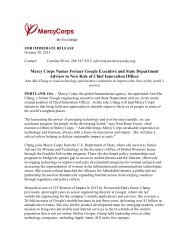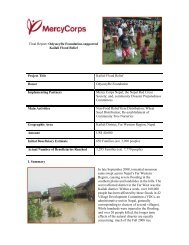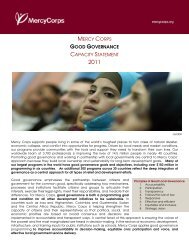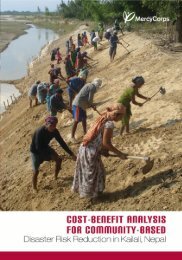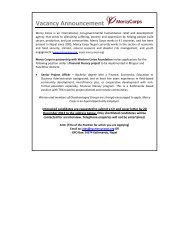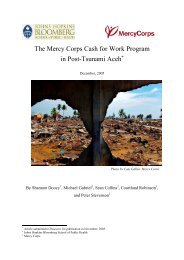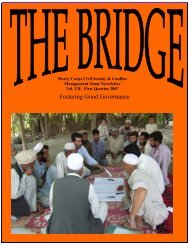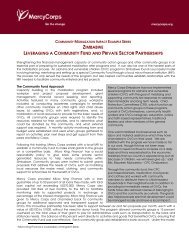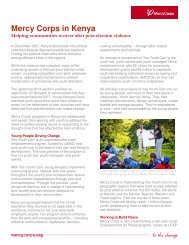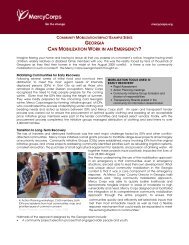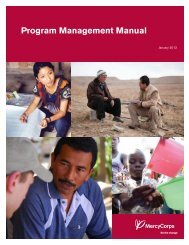SUSTAINABILITY FIELD STUDY - Mercy Corps
SUSTAINABILITY FIELD STUDY - Mercy Corps
SUSTAINABILITY FIELD STUDY - Mercy Corps
You also want an ePaper? Increase the reach of your titles
YUMPU automatically turns print PDFs into web optimized ePapers that Google loves.
the process, which reinforces behaviors and buildsgreater confidence in community capacity.This recommendation echoes previous studies of<strong>Mercy</strong> <strong>Corps</strong>’ community mobilization programs. Inthe evaluation of the CRDA Program in Serbia, theevaluator concluded, “Completing small, quick-startprojects during the startup period were shown to bevery effective as the practice quickly demonstratesthat the organization’s efforts are serious, genuine andin accordance with the needs of the communities.” 22SANDY SHEARD, 2007 FOR MERCY CORPSIn a field study of <strong>Mercy</strong> <strong>Corps</strong>’ USAID-funded EastGeorgia Community Mobilization Initiative (E-GCMI), the evaluators found that “Sustained behaviorchange often does not take place during implementation of the first project” and that the learningprocess of reinforcing skills through multiple applications under the support of the implementingagency contributes to the likelihood of sustained behavior change. 23 Investing in positive outcomesfrom the first project cycle will contribute to greater motivation, confidence and opportunities forsuccess in later cycles, thus instilling confidence in the process.3. Complement larger projects with small-scale opportunities.Despite the confidence building that took place during the programs, some communities still felt thatthey required outside assistance to solve their problems. With program emphasis on implementinglarge-scale, expensive projects that addressed the most pressing priorities of the community, somecommunities and CAG members found it difficult to translate these experiences to independentlyimplement smaller-scale projects. An integrated approach of addressing the big issues through awide-scale mobilization process, combined with encouragement for smaller projects led and primarilyfunded by community members and/or action groups, can aid communities to maintain momentum andconfidence that they can continue to improve their lives, even with limited resources.4. Combine skill-building with practical experience.Some CAG members mentioned that they wrote their first proposal during project implementationand then went on to write many more. Others talked about their experiences learning about and thenapplying group prioritization processes as having a large impact on how they work with thecommunities, and in the case of at least two teachers on CAGs, their students in the classroom.This combination of skill-building through seminars, camps and conferences combined with immediatepractical application builds confidence and ownership of the new skills and encourages their longterm use. Whenever possible, practical application should follow closely on the heels of training andskill-building activities. A similar finding was expressed in <strong>Mercy</strong> <strong>Corps</strong>’ Georgia Field Study, whichconcluded “Fostering and mentoring a number of potential leaders throughout the mobilization process,while at the same time being inclusive of groups that may be excluded from leadership roles(e.g. women, youth and ethnic minorities), is critical to program success and sustainability.” 2422 Ibid. p. 26.23 Hyder, Najia and Young, Anna. Georgia Field Study: Understanding the Legacy of Community Mobilization. <strong>Mercy</strong> <strong>Corps</strong>, July 2004. p. 26.24 Ibid. p. 27Understanding What Promotes Lasting Change at the Community Level23



